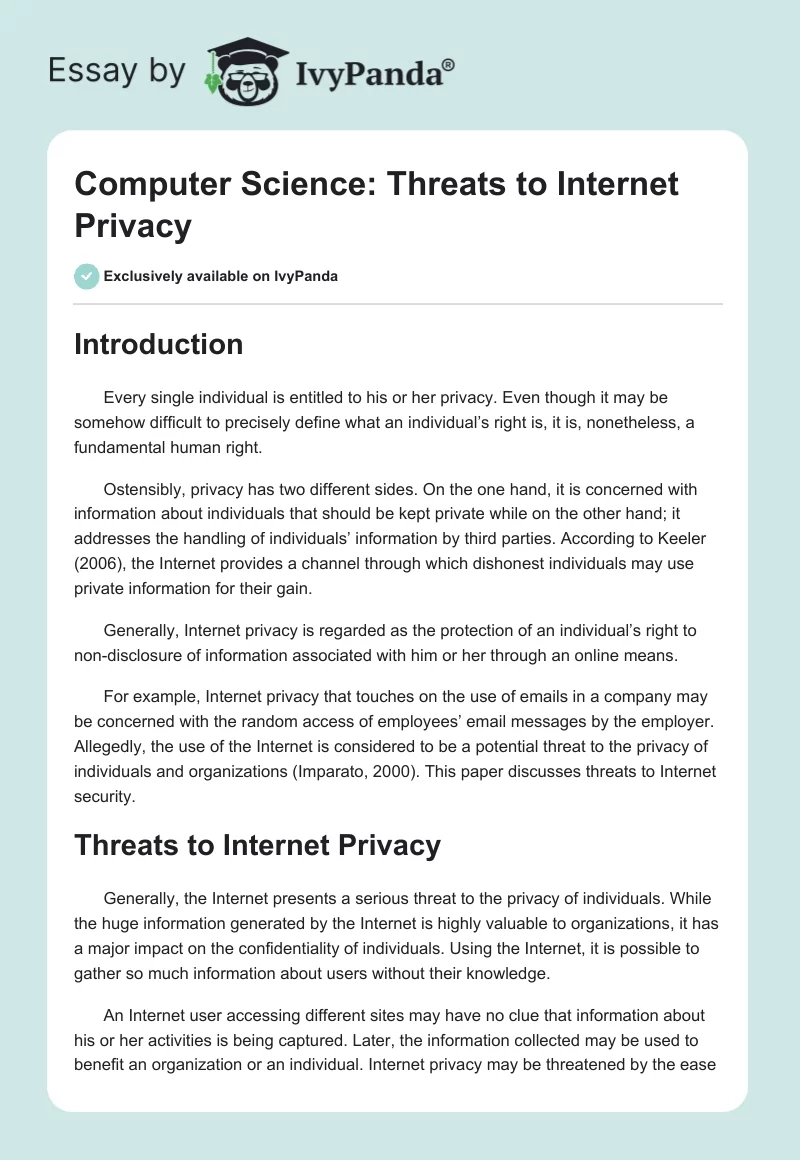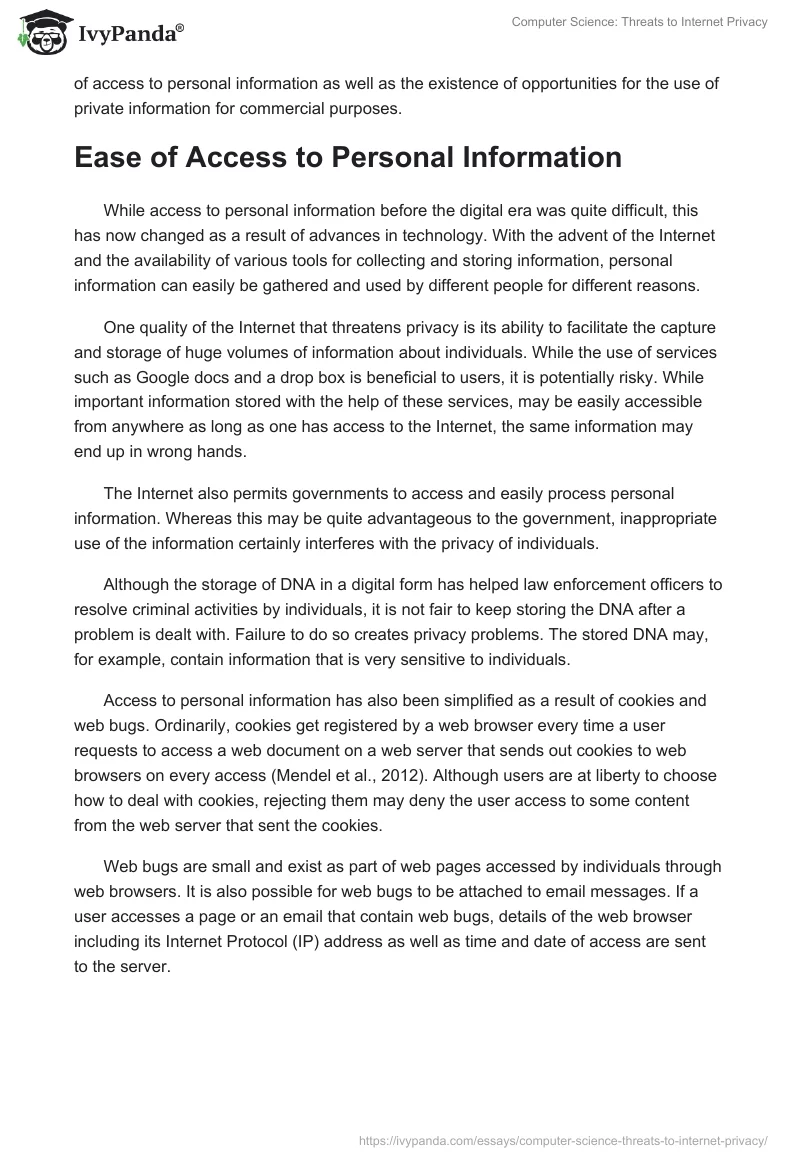Introduction
Every single individual is entitled to his or her privacy. Even though it may be somehow difficult to precisely define what an individual’s right is, it is, nonetheless, a fundamental human right.
Ostensibly, privacy has two different sides. On the one hand, it is concerned with information about individuals that should be kept private while on the other hand; it addresses the handling of individuals’ information by third parties. According to Keeler (2006), the Internet provides a channel through which dishonest individuals may use private information for their gain.
Generally, Internet privacy is regarded as the protection of an individual’s right to non-disclosure of information associated with him or her through an online means.
For example, Internet privacy that touches on the use of emails in a company may be concerned with the random access of employees’ email messages by the employer. Allegedly, the use of the Internet is considered to be a potential threat to the privacy of individuals and organizations (Imparato, 2000). This paper discusses threats to Internet security.
Threats to Internet Privacy
Generally, the Internet presents a serious threat to the privacy of individuals. While the huge information generated by the Internet is highly valuable to organizations, it has a major impact on the confidentiality of individuals. Using the Internet, it is possible to gather so much information about users without their knowledge.
An Internet user accessing different sites may have no clue that information about his or her activities is being captured. Later, the information collected may be used to benefit an organization or an individual. Internet privacy may be threatened by the ease of access to personal information as well as the existence of opportunities for the use of private information for commercial purposes.
Ease of Access to Personal Information
While access to personal information before the digital era was quite difficult, this has now changed as a result of advances in technology. With the advent of the Internet and the availability of various tools for collecting and storing information, personal information can easily be gathered and used by different people for different reasons.
One quality of the Internet that threatens privacy is its ability to facilitate the capture and storage of huge volumes of information about individuals. While the use of services such as Google docs and a drop box is beneficial to users, it is potentially risky. While important information stored with the help of these services, may be easily accessible from anywhere as long as one has access to the Internet, the same information may end up in wrong hands.
The Internet also permits governments to access and easily process personal information. Whereas this may be quite advantageous to the government, inappropriate use of the information certainly interferes with the privacy of individuals.
Although the storage of DNA in a digital form has helped law enforcement officers to resolve criminal activities by individuals, it is not fair to keep storing the DNA after a problem is dealt with. Failure to do so creates privacy problems. The stored DNA may, for example, contain information that is very sensitive to individuals.
Access to personal information has also been simplified as a result of cookies and web bugs. Ordinarily, cookies get registered by a web browser every time a user requests to access a web document on a web server that sends out cookies to web browsers on every access (Mendel et al., 2012). Although users are at liberty to choose how to deal with cookies, rejecting them may deny the user access to some content from the web server that sent the cookies.
Web bugs are small and exist as part of web pages accessed by individuals through web browsers. It is also possible for web bugs to be attached to email messages. If a user accesses a page or an email that contain web bugs, details of the web browser including its Internet Protocol (IP) address as well as time and date of access are sent to the server.
Opportunities for Commercial use of Personal Information
Although the use of the Internet enables businesses to access so much information about individuals for commercial benefits, it hurts the privacy of individuals. Most activities that take place on the Internet rely on the services offered by various middle players including Internet Service Providers and major search engines.
Usually, the approach taken by popular search engine organizations such as Google and Yahoo requires them to use personal information for their marketing activities. Without a doubt, increased access to personal information by intermediaries is to blame for increased disclosure of private information about individuals.
Drawing from a study by Mendel et al. (2012), the presence of go-betweens such as cloud computing capabilities, search engines, and social network sites has worsened the concern about the privacy of individuals. The use of social network sites, for example, permits access to so much information about individuals and thus may be used to violate their privacy.
Due to lack of literacy on media and communication, some Internet users are totally ignorant of the effects of sharing personal information with others. Arguably, many people share personal information with others including those not well known to them without caring about the repercussions of doing so.
The discovery of cloud computing also presents serious privacy challenges. With cloud computing, individuals and organizations can store data and information without owning hardware equipment, and the information can be accessed anywhere when needed.
Although the use of cloud computing eliminates the need to spend on expensive resources to provide for the storage, it exposes private information to a third party who may not be careful to ensure its privacy.
Ordinarily, the task of ensuring the security of software on which data is stored is left with the third party and users have no say. Also, cloud computing is a new concept that is yet to be fully covered under the law. Assurance about the privacy of private information is thus a concern.
Other threats to Internet security include the use of software applications, commonly referred to as sniffer programs. The programs scan information is passing through routers or computers that handle Internet-bound traffic (Schneider, 2014). Backdoor programs may also be used to access and run programs without following the proper authentication procedure.
Conclusion
The advent of the Internet has certainly revolutionized the way information moves from one person to another. This has created serious privacy concerns that users must take note of. Although most Internet services exist for free, efforts must be made to educate users on the effects of free Internet services on their privacy.
References
Imparato, N. (2000). Public Policy and the Internet: Privacy, Taxes, and Contract. Glenwillow, OH: Hoover Press.
Keeler, M. (2006). Nothing to Hide: Privacy in the 21st Century. Lincoln, NE: iUniverse.
Mendel, T., Puddephatt, A., Wagner, B., Hawtin, D & Torres, N. (2012). Global Survey on Internet Privacy and Freedom of Expression. Paris: UNESCO.
Schneider, G. (2014). Electronic Commerce. Stamford, CT: Cengage Learning.


